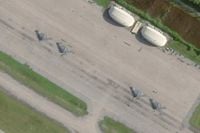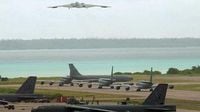A significant amount of US military power has been on the move over this past week, including several B-2 strategic bombers which have landed at the US military base in Diego Garcia in the Indian Ocean, just over 2,000 miles southeast of Iran. According to press reports, this is the most significant B-2 presence on the island in nearly half a decade. Flight trackers are showing increased activity by at least nine KC-135R refueling aircraft in the region. Several C-17 cargo planes have also been spotted by satellites on the island.
The US President has ordered US Carrier Strike Group Carl Vinson to the Mideast. While the Administration continues to escalate its illegal bombing campaign against Yemen—with more than 60 strikes reported on March 29, 2025, alone—speculation is increasing that the Diego Garcia buildup is the beginning of the long process of positioning US military muscle for an attack on Iran. President Trump warned on March 29, 2025, that "if we don’t work it out, bad bad things are gonna happen with Iran."
So, is the US President, who was elected with the promise to end wars rather than start them, ready to launch a war against a modern, technologically advanced nation of 90 million with an extremely complicated terrain, advanced military capabilities, and a newly signed strategic partnership treaty with Russia? No one knows. Congress seems uninterested in its constitutional obligation to serve as the red light or green light for war—there’s been nary a peep over Trump’s bombing of Yemen to, as his top aides were caught saying, "send a message." Does anyone believe they will come out of their slumber as Hegseth, Waltz, Rubio, and the rest of the gang that couldn’t shoot straight (or at least plan a war on Signal straight) position the US for an attack on Iran?
Trump has continued—and perhaps even accelerated—in his second term a pattern of extreme rhetorical escalation followed by retrenchment, possibly as a means of gaining the attention of the party he is addressing. For example, he warned Russia earlier this month that he would increase sanctions and destroy its economy before backing down to a series of lengthy phone calls and lately capitulating to all of Russia’s demands. So, is this a big bluff to get Tehran back to negotiate the deal that Trump himself abrogated when he took office the first time? (And if so, why would Iran trust Washington this time?) Or will Trump heed the call of Israel’s Netanyahu and expend US blood and treasure to take out Israel’s enemies?
Already, Trump’s top picks—including his ambassador to Tel Aviv, Mike Huckabee—who is doing his best Colin Powell impression, claiming that as soon as Iran takes out Tel Aviv, it will turn its sights to Tennessee, are urging action against "the head of the snake," as Bibi is wont to describe Iran. The pieces are falling into place, and Trump’s entire cabinet is chock full of individuals for whom a war with Iran is the single most important item on the foreign policy agenda. As analyst William Schryver points out, Iran is certainly not Yemen, Afghanistan, Saddam’s Iraq, Gaddafi’s Libya, or Noriega’s Panama.
The United States, under four years of mismanagement by whoever was acting as Biden’s brain, has already thrown everything it had available in an attempt to secure a strategic defeat for Russia and lost. The DC neocons move from failure to failure without skipping a beat, even as the US economy is bled dry by the war machine. This war would be the end of Trump’s presidency and could well be the end of the US economy itself—all for an outrageous domino theory presented by, to a large degree, US religious extremists not unlike the religious extremists they claim to oppose abroad—that Tehran is seeking to "take over" the United States. It’s bonkers…yet for those of us who spend decades watching US foreign policy, bonkers usually wins the day. Strap in…
Diego Garcia, the Indian Ocean base the US can use to target Iran, is a speck of an island that few associate with the Middle East but that the US has used for decades to project military power in the region. Throughout this week, the US has been amassing B-2 bombers, stealth aircraft used for precision strikes that can evade air defense systems, at Diego Garcia, an island that's roughly 700 kilometers south of the Maldives, which is home to a joint US-UK military base. The US military confirmed earlier this week that it had deployed B-2 bombers to the island. Open-source satellite information provided by Planet Labs earlier this week showed three B-2 bombers on the US base. On Friday, other open-source accounts shared imagery suggesting at least five B-2 bombers were on the base.
Diego Garcia is part of the Chagos Islands archipelago in the Indian Ocean. The US’s footprint there can be traced back to the waning days of the British Empire. In the 1960s, Britain was pulling out of its colonies but wanted to maintain a few strategic chips on the map to remain a power on the world stage. In the Eastern Mediterranean, they carved out a base on Cyprus. In the Indian Ocean, they pressured Mauritius, a former British colony, to sell the Chagos Islands for just £3 million. To build a military base on Chagos’ largest island, Diego Garcia, the British forcibly displaced around 1,500 native islanders without compensation into slums in Mauritius and the Seychelles.
The US sealed a 50-year lease on the base with a 20-year right to extension in 1966, as part of a secret agreement that saw the US reduce the cost of American ballistic missiles to the UK in return for the base. The base has been critical to US power projection in the wider Middle East and Indo-Pacific, becoming the go-to base when the US is in a pinch. For example, in the late 1990s, the US was conducting sporadic bombing runs against Saddam Hussein’s military, but Saudi Arabia dragged its feet about allowing the US to launch warplanes from their airfields. American military strategists drafted plans for B-52 bombers based in Diego Garcia to bomb Saddam’s Iraq.
The Gulf states, until recently, had all imposed strict limitations on the US using their air bases to strike the Houthis in Yemen, a US defense official told MEE. The Trump administration was able to obtain permission during its recent attacks on the Houthis, but allowing the US to bomb Iran directly from their states would be riskier for the Gulf monarchs. American bombers flew directly from Diego Garcia to hit targets in Iraq and Afghanistan during the “War on Terror,” and Diego Garcia was used for refueling. This week, satellite imagery has shown multiple KC-135 refueling aircraft at the base.
Rising tensions with Iran are putting Diego Garcia back in the spotlight. The buildup of B-2 bombers comes as the US and Tehran both engage in a show of force ahead of potential nuclear talks. The US has already launched deadly strikes on the Houthis in Yemen, who are aligned with Iran, in what many analysts see as a signal to Tehran. The B-2s are capable of carrying 30,000-pound “bunker-buster” bombs that would be needed to penetrate Iran’s nuclear sites deep underground, known as the Massive Ordnance Penetrator. Their basing at Diego Garcia puts the bombers within 4,000 kilometers from Houthi territory and 5,300 kilometers of Iran, well within their refueling range of approximately 11,000 kilometers.
Speaking to reporters on March 28, 2025, Trump said, “My big preference is, we work it out with Iran. But if we don't work it out, bad, bad things are going to happen to Iran.” Trump's comments came a day after Iran’s foreign minister, Abbas Araghchi, said Tehran had responded through intermediary Oman to a letter from Trump calling for nuclear talks. Araghchi stated that indirect talks with the US would continue, but Iran was “firm on not engaging in direct negotiations under maximum pressure and military threats.” Axios reported previously that Trump’s March letter set a two-month window for talks or warned of military action.








